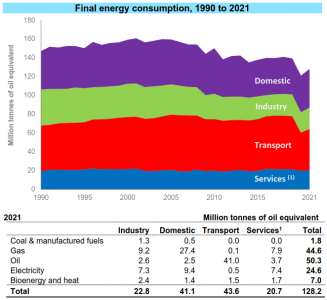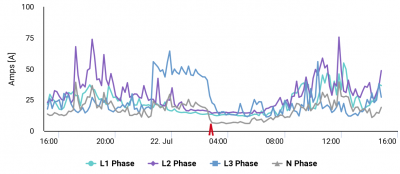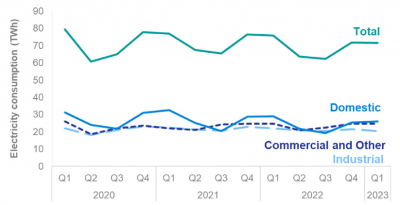Posted by: @chickenbigEach battery has its own 125A fuse before the connections to the bus bars, then a 125A fuse between bus bars and inverter.
OK. It depends on the type of fuse, but I wouldn't expect a 125A fuse to blow for several minutes if I exceeded it's rating by 50% or so!
That's the sort of overload which I'd be handling with an MCB.
Posted by: @chickenbigWith great power comes great responsibility.
Try suggesting that as a motto for MCS and let's see how far it gets. 😉
Posted by: @sikorsky92I’ve supplied over 100 seplos units to the U.K. including various inverter configs to go with these.
Thanks; that's useful to know.
We're bound to differ on a number of points.
I'm not a supplier, but a designer.
My main interests here are:
- Establishing widespread agreement of safe practices
- discussing deficiencies in the design of existing equipment
- identifying components/devices required for efficient/effective use of on/off-grid storage which do not yet exist
- designing such devices if I'm able to do so
- exchanging information with the relevant bodies: Ofgem, DESNZ, MP, DCC & SEC (smart meters), ENA & DNO
- with a view to amending the regulatory framework/law as required
Posted by: @sikorsky92are we still speaking about seplos BMS here and a way to get this to work or just prismatic cells as a whole?
Both I hope.
I'm deducing generic points whilst being engaged in this as a Seplos topic.
Posted by: @sikorsky92lots of people are now using purely off peak charging to save money these days without solar so this works extremely well.
Sure. That's also of interest... especially as I live in an area which discards excess renewable generation whilst a high proportion of local households suffer energy-poverty.
But the usual definitions of 'off peak' and 'peak' won't last much longer.
The present ToU tariffs from Octopus are based on National supply/demand.
There's not great correlation to the actual available wind/solar generation in my area.
The UK is moving towards Nodal Pricing, which is essential for better uptake of renewable sources.
The off-peak period in the middle of the night will disappear as the proportion of EVs increases.
The typical demand to recharge an EV is twice as much as the daily consumption for household which owns it.
Save energy... recycle electrons!
I wouldn’t be too sure about that tarriff disappearing. As generation plants grow there is still excess renewable power that requires to be taken from the grid when power is low. EV’s will grow I agree however the idea that it will grow to the demand to delete that tariff I disagree with.
The main electric usage is industrial and through the day.
Posted by: @sikorsky92The main electric usage is industrial and through the day.
Much as I admire your view of the industrial strength of the UK, you and the Government Office of National Statistics are in disagreement 😎
Posted by: @sikorsky92I wouldn’t be too sure about that tarriff disappearing.
We vary in our opinion.
Outside of the UK's major/metropolitan cities, the underground cables which deliver the final few hundred meters of (LV) electricity to our homes are unable to sustain much heavier use.
When they were laid into the ground over the last 50+ years, they were deliberately undersized, in the same way that electricians use diversification rules when wiring a home.
The underground cables were allowed to heat up during the evening peak period, but this was mitigated by them to cooling down again overnight.
Adding EV chargers removes that period of cooling-down, which results in damage due to thermal stress.... and hence more power outages.
Moreover, since most UK houses have single-phase supplies, there is an increase in phase-imbalance at the local substation when EV chargers are installed.
That results in current flowing in the neutral, which was originally sized on the basis that it will carry negligible current.
To illustrate this, I've just picked up the following data from a substation on an urban estate in a town of 95,000 people.
This plots current-per-phase over the past 24hrs.
It shows considerable phase imbalance - and that causes losses at the substation transformer.
You will notice that the grey (neutral) line is carrying as much as one or two of the phases right up until 3am, where I've added a red arrow.
That's a serious problem.
Either we dig up and replace all our underground cabling in residential areas, or else we change the times at which our Smart-chargers take power from the grid.
The latter option is cheaper and can be undertaken rapidly by Ofgem issuing a licence variation.
In turn that affects when us users of home batteries will take electricity from the grid.
Save energy... recycle electrons!
Posted by: @transparentIf you want to check the SoC, then install a separate colomb-counting meter with a shunt or Hall-effect sensor which covers both/all your batteries.
Isn't this what the inverter does for itself? It provides fairly detailed graphs of charge (well, current) in and out of the batteries as a whole. I'm not sure how prone it is to drifting.
Posted by: @sikorsky92are we still speaking about seplos BMS here and a way to get this to work or just prismatic cells as a whole?
I would think that the lessons are fairly generic and apply to all BMS. My concern was over-charging the batteries through the use of float voltages which are higher than the natural resting voltage of the battery pack. I feel the inverter controls are a fairly blunt instrument, and as this is not my setup (and is one I don't have good remote access to) I'm trying to be conservative. When I had issues with getting the battery to discharge (due to me setting "System Mode 1" incorrectly) I reached for "AGM V" as a possible solution (which failed), but did not get the chance to try out "AGM %" due to time running out.
I guess that the same over-charging can occur with BMS integration too (as I could not see a Seplos BMS option to back off re-charging the pack, nor a Sunsynk inverter setting in the style of Victron's "Re-bulk voltage offset" ... which uses voltage as a SoC proxy ...).
It feels as if we are differing on the effect of the float voltage (inverter setting and the resting voltage of the battery pack) and potential issues. Does holding a LiFePO4 cell at 3.45V indefinitely cause harm through overcharging? Should we be concerned about the effect on weaker cells which could be held at > 3.45V (i.e. the weak getting weaker)?
Posted by: @transparentMuch as I admire your view of the industrial strength of the UK, you and the Government Office of National Statistics are in disagreement
To be fair the graph is energy consumption rather than electrical consumption.
chart 5.1 shows a quarterly breakdown by sector, with fairly even split between industry, commercial and domestic. Domestic shows annual variation with the other sectors less so. It would certainly be interesting to see consumption per sector bucketed by hour (for instance).
Posted by: @chickenbigTo be fair the graph is energy consumption rather than electrical consumption.
Yes, I was too eager to post.
I should've sought out a graphic depicting electricity-only.
I've inserted the relevant diagram to your previous post.
Save energy... recycle electrons!
Posted by: @chickenbigIt would certainly be interesting to see consumption per sector bucketed by hour
That's tricky. The internet has lots of data bout domestic demand per half-hour, but industry is only discussed in terms of monthly/yearly trends.
One way would be to obtain the UK's half-hour volume figures from EpexSpot, and then subtract the domestic consumption.
That would leave us with an amalgamation of industry/commercial/other in what's left.
It is a data-set which National Grid ESO will have, but I only have immediate access to data from National Grid Electricity Distribution (NGED).
Save energy... recycle electrons!
Posted by: @transparentOne way would be to obtain the UK's half-hour volume figures from EpexSpot
I would guess that industry would not go to the spot market too often, unless they are covering shortfalls in renewable generation. Industrial processes are predictable, so the requirements could be hedged well ahead of time. At least that is what I'd do.
I agree. So this needs a data request to ESO and a large hook to drag this topic back on target...
Suffice to say that we must have off-grid battery system controllers which are capable of acting in response to a wider range of factors than the primitive overnight cheap-rate which we've become accustomed to.
To be DNO-friendly, there are two other issues I'd like to see being considered:
a: Once we know the power which needs importing from the grid (for that particular day), I'd like to see that import spread over as long a time-frame as possible.
So if we need 6kWh and there's 4-hours of low-cost (or low-carbon) electricity available, we don't take it all in the first 90-mins just because our inverter could do so!
b: We should slowly ramp up the current being drawn from the grid over several minutes.
The sudden ON command which gets sent to our EV Smart-Chargers is a really unsmart way to treat the grid.
Whoever sanctioned that?... Oh yes, Ofgem. 😥
Save energy... recycle electrons!
Posted by: @sikorsky92I wouldn’t be too sure about that tarriff disappearing. As generation plants grow there is still excess renewable power that requires to be taken from the grid when power is low. EV’s will grow I agree however the idea that it will grow to the demand to delete that tariff I disagree with.
The main electric usage is industrial and through the day.
Many industries within which I have worked have operated throughout the full 24 hours, either Monday to Friday or the full 24/7.
Posted by: @transparentOnce we know the power which needs importing from the grid (for that particular day), I'd like to see that import spread over as long a time-frame as possible.
Does the existing smart meter system allow intention to be declared?
Intentional charging is something that Intelligent Octopus appears to do, by controlling car charging through an app, which perhaps works around the black-box nature of the smart meter by not interacting with it. It may not be ideal but it does seem to allow for an alternative control path and potential to plan ramp-up and down in a coordinated (down to the node) manner. Given the slow adoption of existing smart meters and lack of features used, I think an alternative way of managing the load needs to be explored, even if that is non-standard.
And moving up one level, how do we ensure our inverters have been installed in accordance with ENA standards? As I have seen, the self-certification of an MCS installer is very much insufficient to ensure grid stability at (nearly) the most basic level since inverter firmware versions need to be correctly set, as well as the grid-mode being selected. Should we be testing electrical infrastructure through planned service outages? My guess is that over/under frequency/voltage are hard to perform a controlled test for!
Whilst I intend to install some battery storage at some point the future, I wonder if domestic battery storage systems are the most cost effective solution to lopping the peaks and filling the troughs of the electricity supply system.
In the first place I doubt that a large proportion of the population would have the money, technical know how, or inclination to install and operate such a system.
As has been highlighted about EV's, battery storage systems can exacerbate grid and phase imbalance.
National Grid and DNO's have no direct control over the charging and discharging of such systems.
In my opinion there needs to be a co-ordinated plan, that includes not only additional renewable energy production, but also large scale energy storage. As far as I am aware no such plan yet exists.
- 26 Forums
- 2,364 Topics
- 53.6 K Posts
- 242 Online
- 6,027 Members
Join Us!
Worth Watching
Latest Posts
-

RE: Speedcomfort radiator fans
I have to agree. Given, on Amazon, I can find a pack of...
By Majordennisbloodnok , 34 minutes ago
-
RE: Solis S6-EH1P8K-L-PLUS – Why I Chose It and What I’ve Learned So Far
@bash brilliant, thanks for the feedback
By energy9165 , 45 minutes ago
-

RE: Setback savings - fact or fiction?
The OpenWeatherMap API provides plenty of historical da...
By Majordennisbloodnok , 49 minutes ago
-

RE: Heat Pump Heats the House… But It’s Not Cosy. Emitter Changes or System Tweak?
@alastair There I was, feeling grumpy, he said “Cheer u...
By Toodles , 3 hours ago
-
RE: Grant Aerona: Is there a setting to keep the 2-port valve open during pump blockade
Depends on OAT. Mine cycles at OAT>10 and of course...
By JamesPa , 4 hours ago
-
RE: New Fogstar 15.5kWh upright solution
@transparent My conclusion is as you have noted, tha...
By Bash , 5 hours ago
-

That makes sense to me,although we don't know what the ...
By Transparent , 7 hours ago
-
RE: Mitsubishi Ecodan R290 10kW performance
And to you too. Wishing you a very enjoyable festive s...
By Sheriff Fatman , 7 hours ago
-

RE: External pipework insulation
They do? But that isn't apparent from the photos we'r...
By Transparent , 9 hours ago
-
RE: My Powerwall 3 Consumes 3-4 kWh/Day in Self-Consumption: Is This Normal?
@editor Thank you so much for looking into this for me ...
By Caron , 10 hours ago
-

RE: Say hello and introduce yourself
@velcro welcome to the forums. Please feel free start a...
By Mars , 23 hours ago
-
Daikin EDLA11D3V3 DHW Settings
I have a newly installed EDLA11D3V3 which I'm still get...
By Velcro , 1 day ago
-

@jamespa I have found that it comes as a shock when we ...
By Toodles , 1 day ago
-

RE: Need Help Optimising My Rushed ECO4 Install: 12kW Bosch Heat Pump
Hi @mickamills . Welcome to the forum. It sounds like...
By bontwoody , 1 day ago
-
RE: Midea ASHP – how to set weather compensation
@curlykatie did you get sorted with this?
By MickaMills , 1 day ago
-
RE: Octopus Cosy Heat Pump Owners & Discussion Thread
The FT levels off at either the set point OR the minimu...
By AndrewJ , 2 days ago
-
RE: MyVaillant Connect Regular Disconnect
Thanks. Yes, if the time is consistently 11pm every nig...
By buckwem , 2 days ago
-
RE: Who's your electricity provider and what's your tariff?
@transparent Thanks, this helps. Could it be that St...
By Batpred , 2 days ago









